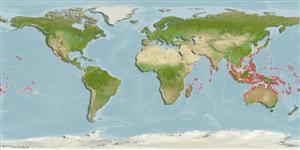Holothuroidea |
Synallactida |
Stichopodidae
Environment: milieu / climate zone / Mức độ sâu / distribution range
Sinh thái học
Cùng sống ở rạn san hô; Mức độ sâu 0 - 15 m (Tài liệu tham khảo 122). Tropical; 36°N - 35°S, 29°E - 134°W
Indo-Pacific, excluding Persian Gulf and Hawaii. Tropical and subtropical.
Length at first maturity / Bộ gần gũi / Weight / Age
Chín muồi sinh dục: Lm ? range ? - ? cm Max length : 40.0 cm TL con đực/không giới tính; (Tài liệu tham khảo 75656); common length : 18.0 cm TL con đực/không giới tính; (Tài liệu tham khảo 122); Khối lượng cực đại được công bố: 1.5 kg (Tài liệu tham khảo 75656)
Mean live weight: 100-400 g. Body-wall thickness 0.2 cm. Body firm, rigid with quadrangular section, flattened ventrally (trivium); body wall easily disintegrates outside sea water. Radii of bivium with characteristic double row of large papillae, each radius ending in a small red or orange papilla. Trivium delimited by characteristic double row of large papillae; stout podia arranged regularly on 3 radial bands, with 10 rows in the medio-ventral band and 5 in the lateral. Mouth ventral, surrounded by a row of papillae and 20 green, stout tentacles. Anus terminal. Calcareous ring with large radial pieces and narrow interradials. Cuvierian tubules absent. Cloaca large and greenish. Bivium dark green to black; trivium lighter. Spicules with very characteristic tables with a narrow disc showing 4 holes, bearing a spire generally ending in a moderately spiny crown; tables with larger disc and simpler crown also present; presence of many C-shaped spicules; rosettes absent; tables in dorsal with have a large multiperforated disc, bearing a large spire; ventral papillae with long, smooth rods; ventral podia with denticulate rods and large multiperforated plates; tentacles with smooth and granular rods.
Probably harvested in some artisanal fisheries of the area. Collected by hand at low tide, or by divers. The processed product is of low commercial value. A reef species mostly found in shallow areas from near the surface to a depth of 15 m (Ref. 122). Found on sandy areas (Ref. 115900) and generally occurs on reef flats and upper slopes. Populations reaching high densities on hard substrates, with a mean of around 0.04 per square meter. Shallow water populations are generally smaller in size than those found in deeper waters. Biology poorly known (Ref. 122).
Life cycle and mating behavior
Chín muồi sinh dục | Sự tái sinh sản | Đẻ trứng | Eggs | Sự sinh sản | Larvae
Members of the class Holothuroidea are gonochoric and have only one gonad. Spawning and fertilization are both external and some exhibit brooding. Life cycle: Embryos develop into planktotrophic larvae (auricularia) then into doliolaria (barrel-shaped stage) which later metamorphose into juvenile sea cucumbers.
Conand, C. 1998 Holothurians (sea cucumbers, Class Holothuroidea). p. 1157-1190. In Carpenter, K.E. and V.H. Niem (eds.) FAO Species Identification Guide for Fishery Purposes. The Living Marine Resources of the Western Central Pacific. Vol. 2. Cephalopods, crustaceans, holothurians and sharks. FAO Rome. (Tài liệu tham khảo 122)
IUCN Red List Status
(Tài liệu tham khảo 130435: Version 2025-1)
CITES status (Tài liệu tham khảo 108899)
Not Evaluated
CMS (Tài liệu tham khảo 116361)
Not Evaluated
Threat to humans
Harmless
Human uses
Các nghề cá: buôn bán nhỏ
| FishSource |
Các công cụ
Thêm thông tin
Sinh thái dinh dưỡngFood items (preys)
Thành phần thức ăn
Thành phần thức ăn
Các động vật ăn mồi
Life cycleSự tái sinh sảnChín muồi sinh dụcSự sinh sảnĐẻ trứngEggsEgg developmentLarvae PhysiologyThành phần ô-xy
Human RelatedStamps, coins, misc.
Các nguồn internet
Estimates based on models
Preferred temperature
(Ref.
115969): 24.7 - 29.3, mean 28.4 (based on 3352 cells).
Thích nghi nhanh
Chiêù cao, thời gian nhân đôi của chủng quần tối thiểu là dưới 15 tháng (K=0.45).
Fishing Vulnerability
Moderate vulnerability (36 of 100).
Price category
Unknown.
